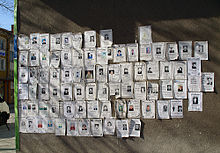Obituary

An obituary notice ( obituary notice , in Austria party ) is the public announcement of a death . This usually indicates the date and place of the church or secular memorial service . In obituaries, private individuals report the death of a relative, companies and institutions announce the death of an employee or entrepreneur and posthumously honor the deceased; clubs also occasionally publish advertisements for deserving members. As a result, there may be multiple obituaries posted for one person.
A death is announced via an advertisement in one or more newspapers and to individual addressees via a printed memorial letter or a memorial card. The latter occurs in particular with people who live outside the publication area of the newspaper in question.
A few days or weeks later, they are often given thanks . The obituary is usually drafted in the consultation with the undertaker, for which he has templates ready. It can also be ordered directly in a newspaper's advertisement.
General
Obituary notices in newspapers are usually under the heading of family advertisements, which also include advertisements about birth, engagement, wedding or an anniversary, but which are much rarer. The obituary is usually rectangular and framed in black. They range in size from very small formats to full-page advertisements; it is not uncommon for obituaries to appear on the Internet. According to German customs, such newspaper advertisements can be large; in many other countries this is considered unusual.
The display usually contains the following information:
- First and last name (and maiden name) of the deceased, occasionally also nominal or nickname, for members of religious orders the name of the order
- Date of birth and death (sometimes also the date of ordination for Catholic priests )
- Place of birth and death
- the names of the bereaved (relatives, including friends, colleagues, neighbors, employees, partners)
- Comments on the personality, occupation , career and characteristics of the deceased
- possibly thanks to nurses and medical professionals
- possibly a religious or ideological symbol
- possibly a mourning sentence
- possibly comments on the time of suffering and / or the cause of death
- details of the funeral service , e.g. B. Date, address, donations, mourning clothing and condolences (e.g. the request not to express condolences at the open grave ). In the case of the deceased of the Catholic faith, reference is often made to the rosary , the soul mass and the six-week ministry .
Increasingly, a portrait photo of the deceased is placed alongside the text. Obituaries can also be found in new forms of mourning and commemoration (see virtual cemetery and memorial page ).
The phrase "Instead of cards" indicates that no separate obituary notices will be sent as a letter.
history
Until the early modern period , dying was a public affair, with the number of people present when a person was dying underscored their rank and importance. The news of the death was distributed generally by notice of the pulpit and individually by the corpse bitter . The lament for the dead and other mourning customs, u. a. The bells for the dead , lay out , mourning clothes and funeral marches were supposed to honor the dead. The tradition of public billposting on death lists has been preserved in some regions of Europe to this day. In Germany, it is still most common in parishes and parishes of both Christian denominations for their deceased members.
With the emergence of newspapers, the small advertisements, initially presented in a very simple form, established themselves, which over the years has changed to the relatively firmly established form of the present. The first obituary notice can be found in Ulm in 1753. In the 19th century, independent newspaper sections under the title “Deceased” published the current list of the dead. Such pure lists, which usually only give the name and the life data (often in connection with the last residential address) of the deceased, are still common today as official publications by the registry offices in some cities and municipalities, but due to data protection it is or is abandoned in many places only practiced if the relatives agree.
See also
literature
- Klaus Dirschauer: Death that was hushed up. Theological Aspects of Church Burial . Schünemann Verlag, Bremen 1973, ISBN 3-7961-3040-2 , pp. 22-48.
- Stella Baum: Suddenly and unexpectedly . Erb Verlag, Düsseldorf 1983, ISBN 3-88458-010-8
- Karl-Wilhelm Grümer and Robert Helmrich: The obituary . Much read but little known: a description of a little-developed research material . In: Historical Social Research , Vol. 19 (1994), No. 1 (= No. 69), pp. 60-108.
- Matthias Nöllke and Christian Sprang: Out of the mouse. Unusual obituaries . Kiepenheuer & Witsch, Cologne 2009, ISBN 978-3-462-04157-6
- Matthias Nöllke and Christian Sprang: We are incredible. New unusual obituaries. Kiepenheuer & Witsch, Cologne 2010, ISBN 978-3-462-04249-8
- Klaus Dirschauer: The origins of the obituary . In: funeral culture. A magazine of the Bundesverband Deutscher Bestatter e. V. 64th year 2012, issue 10, pp. 10-12.
- Klaus Dirschauer: The obituary. A posthumous announcement of life . In: funeral culture. A magazine of the Bundesverband Deutscher Bestatter e. V. 64th year 2012, issue 10, pp. 30–32.
- Christian Sprang and Matthias Nöllke: I'll get out of the field. The very latest unusual obituaries. Kiepenheuer & Witsch, Cologne 2013, ISBN 978-3-462-04549-9
- Klaus Dirschauer: Just wait, you'll soon be resting too ... Literature quotes on obituaries . In: funeral culture. The magazine of the Federal Association of German Undertakers. 65. Vol. 1/2014, pp. 16-18.
Web links
Footnotes
- ↑ pdf ( Memento from February 1, 2014 in the Internet Archive )
- ↑ Karl-Wilhelm Grümer and Robert Helmrich: The obituary. Much read but little known: a description of a little-developed research material. In: Historical Social Research, Vol. 19 (1994), No. 1 (= No. 69), pp. 60–108, here p. 68.
